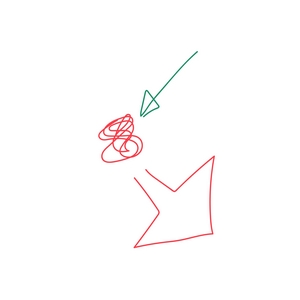Life happens. And it can happen very suddenly. When events carry with them even a tiny
echo of something we haven’t yet finished reacting to, they become triggers. As triggers,
they arrive at our nervous system and hit our baggage. This typically sets off a reaction in
us, which can paradoxically sometimes be to have no obvious reaction at all. These reactions
then seem out of proportion to the original trigger, at least to someone who is unaware of our
baggage.
So to straighten all of this out for ourselves and for others we must first identify the trigger.
With a bit of practice we can get good at knowing that we have been triggered, becoming
aware of how reactive we are being, or how shut down we’re being. The question is when did
it start? What was the beginning of the trigger?
Often, we see this most clearly in how we want to react to another person. Being triggered
often makes us want to verbally abuse someone else or to never talk to them again because,
of course, we’re triggered. That’s the reaction taking over. Instead of doing this, our goal now
is to look at this reaction as if from outside of yourself and to talk through an objective
description of your own process.
It’s difficult, which is why it takes practice. The following formula is designed to guide you
in this practice. Remember, the goal is to open up a window into your nervous system so that
the other person can see all of you, not just what presents on the outside.
When you identify a trigger, you want to keep it as simple as you possibly can. One way to
think about it is:
· What did I see?
· What did I hear?
Try to answer these questions as if you were writing a film script to show the director what
action to film and which noise to record. This is important because most of the time, when we
are triggered, we want to focus on these other questions instead:
· Why the other person is an arsehole
· Why they are wrong
See the difference? All I want you to do is describe the trigger in the diagram below with
specific reference to an actual incident.

So we start with the green arrow, the trigger. It is not a judgement about another person. It is
not a character assassination. It is not forgiveness, either. It’s just a green arrow. Something
happened; an action or a sound or both. That’s it.
Your job, as you recalibrate your nervous system, is now to describe this diagram to yourself
or others with words that are about you, not about someone else. When you do this, you’re
finding a healthy way to talk about triggers. That also makes it safer for others too.
Let’s use an example to see how we can apply this technique in practice.
John has agreed to pick up Mary from a work drinks event and take her to a dinner with his
friends. He’s supposed to collect her at 7pm. At 6.55pm, she tells everyone she has to go, gets
ready and is expecting him. He doesn’t show up. There’s no call, no message, nothing. As
she’s waiting by the lobby of the bar, some of her colleagues leave together and comment
that they thought she’d left. They ask her if she’s OK. Mary smiles bravely and tells them that
everything’s fine. But inside she’s dying. She has no idea what’s going on and having played
it all cool, like she had to leave because she had another event to go to, now she’s the one
standing on her own looking foolish. It doesn’t help that one of the people passing her in the
lobby is her work nemesis! John finally turns up at 7.50pm. Mary is still waiting, but not
exactly pleased to see him. As he walks into the bar, all flustered, and greets her, she must
make a choice in what to say.
For Mary to appropriately address the situation, which of the following responses would you
recommend?
A. Hi.
B. Don’t you dare come near me!
C. Where the *@!% have you been?
D. (sobs) I’ve been so alone (sobs uncontrollably).
E. If you ever so much as think of trying to make another plan with me again, I will kill you.
F. When we agree to meet at 7pm and you show up at 7.50pm, that’s a trigger for me.
G. Let’s go. I don’t want to talk about it.
H. Don’t worry about being late. It’s really no big deal.
I. You are such a huge arsehole.
You can probably think of a few choice lines of your own too. It’s kind of satisfying, isn’t it?
Thinking about how to swing the verbal bat or how to squeeze every last ounce out of a guilt
trip, not to mention the pure twisted pleasure of a passive-aggressive attack of seething,
smiling rage is great fun. But none of it is going to benefit your nervous system.
Give yourself a big pat on the back if you went for F, because that’s the right answer. See
how simple it is.
You have to start to think about everything, first and foremost, from the point of view of the
nervous system. The diagram at the top of this blog should be your visual starting point whenever you feel uncomfortable. It should be in your mind’s eye all of the time.
That is why it is on the cover of this book. Use it. Memorise it. Commit this diagram to
memory and bring it up whenever something feels difficult. Then go find the green arrow.
It’s not always easy. This process can become highly subjective and often a bit confusing.
But if you hold onto the idea that you are painting a picture of the diagram above and that
your first job is to describe the green arrow, it gets much clearer. If instead you find yourself
judging or abusing someone, then you are not in the right place and it’s time to take a
moment, reset, and come back to the diagram above.
This diagram is so useful because it shows that the important person in the story is you. It is
not being caused by someone else. It is being caused by your experience; the sights, sounds,
smells, sensations that are arriving at your nervous system. Just describe these. Leave out the
temptation to judge everything which led up to it and attaching motivations to the people
involved.
You can download this post in a handy 2-page PDF to print and share with friends, family, clients or colleagues. Follow this link to download now.
You can buy a copy of The Invisible Lion now on kindle or paperback from your local Amazon store. Just click here to buy now.


